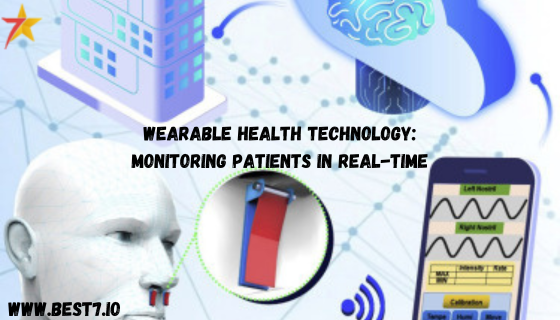
For hospital patients, monitoring has long been a fundamental tool for managing health and reducing disease risk and this certainly hasn’t changed in the modern era, thanks to wearables. Fitness trackers and smartwatches are being tapped to gather real-time health metrics — a treasure trove of data for healthcare providers and users. The future advancements in digital health are clearly focused on real-time monitoring of chronic disease management and preventive care.
The Emergence of Wearable Health Tech
The rise of wearable health technology has made it one of the more fashionable trends in recent years. The global market for wearable health technology is projected to surpass $60 billion by 2025, a trend fueled by the rising emphasis on continuous patient monitoring and personalized health management solutions. The user-friendly design of these devices means that monitoring their health is not only for tech enthusiasts or early adopters.
Two of the most popular wearable devices include fitness trackers and smartwatches. They can track a whole host of different health metrics like heart rate, sleep patterns, physical activity or even stress levels. In the United States, about 30% of adults reported owning a fitness tracker or smartwatch in a survey conducted by Pew Research Center. This large-scale adoption is an important step forward in preventative health management.
Real-Time Data And Patient Monitoring
Real-time data is the leading value proposition for wearable health technology. Monitoring of vital functions and health metrics, thus supporting precision health through timely interventions and better outcomes. In one case, a study published in the Journal of Medical Internet Research showed that wearable devices can reduce hospital readmissions by 40% for chronic disease like heart failure and diabetes .
The use of real-time data collection allows healthcare professionals to monitor the state of their patients more closely, and can implement personalized treatment plans adapted to individual requirements. This results in healthier, engaged patients and an increased sense of ownership over one’s own health.
Chronic Disease Management
One area that stand to benefit the most from wearables is chronic disease management. Continuous monitoring of physiological parameters can help patients with chronic conditions such as diabetes, hypertension and asthma. For example, those living with diabetes can use wearables combined with glucose monitors to continuously monitor blood sugar levels going across the day enabling them to stay healthy.
According to recent data, patients who use wearable technology for management of chronic diseases have better health outcomes. A review in Health Affairs determined that wearable health tech helped increase chronic disease patients’ compliance with disease management by 20 percent. The study cites the instant feedback these tools offer, which helps inform patients about their health status.
The Role of Telehealth
An era boasting telehealth and wearable health technology that work in conjunction to deliver enhanced patient monitoring. The healthcare experts can consult and follow up with the patients by connecting remotely via telehealth platforms instead of in-house visits. This integration simplifies the healthcare plan and helps patients to access necessary care easily.
Pairing telehealth and wearables creates an open line of communication between patients and healthcare providers. Wearables collect data that can be shared in real time allowing for medication, or patient guidance if needed by healthcare professionals responsible of the treatment plan. With a report from the American Telemedicine Association showing 76% of healthcare providers believe that telehealth and remote monitoring enhances patient care, these technologies have become essential tools within modern healthcare.
Biometric Data & Health Apps
Collecting more data such as heart rate variability, sleep quality, and blood saturation of oxygen due to improvements in wearable health technology. It Has A Data Storage That Can Help Us Diagnose A Medical Problem Before It Go Extremely Out Of Hand. Insights from biometric data could be used to target specific health interventions, which would provide individualized recommendations based on a unique pattern of health for that person.
Wearable health apps make it far easier to track metrics. A recent research published by the American Journal of Preventive Medicine suggests that users who use health apps with wearables are 40% likely to achieve their fitness targets. They will be able to set reminders for themselves, track their progress and also get links to educational resources via these apps, all this so that people can remember to be more pro-active about their health.
Preventative Care and Data Analytics
Wearable health technology has only enhanced the recognition of preventive care in clinical systems. Since these devices make it easier to measure health metrics on a regular basis, they can be incredibly powerful for identifying potential issues early. Preventive care is the cornerstone of improving health outcomes and reducing the incidence of chronic diseases.
When it comes to wearables, there is no contention that the profit lies in data analytics. They can stream the inordinate volume of data that these devices generate into complex algorithms which are able to glean insights and patterns. For instance, predictive analytics enabled healthcare providers to predict possible health crises according to the analysis of data gathered through various resources. According to a report by the National Institute of Health, data analytics embedded in wearable health tech can prevent the growth of health issues that currently escalate healthcare costs, to have a potential savings up 15% in healthcare.
Patient Engagement & Personalized Health
Wearable health tech boosts patient involvement Wearables, by providing you with information about your fitness in real time, prompts a sense of responsibility and motivation. People will become engaged like never before in their health—they can see the data coming from their devices and are in control to make health decisions based on this data.
Wearable technology is an ideal fit for what is rapidly becoming a consumer-based approach to health. The premise behind the service is that it learns from individual health data and thus adapt specific recommendations, a factor that would make people more likely to lead healthy lifestyles. Research shows that personalized interventions result in significantly greater benefit magnitude on health outcomes compared to standardized interventions.
Technology in Healthcare
Using technology within healthcare has been a big change for transforming patient care. Wearable health tech leads this digital transformation, which presents creative approaches for controlling and managing patient health. The World Health Organization estimates that from 2025, digital health technologies— such as shocky wearables — will be routine weapons of healthcare systems.
Wearable health technology from here on out is sure to hit new heights when it comes to patient monitoring. Wearables will also bring sensors of high-quality, AI convenience, and interoperability with other health devices that will significantly improve the capabilities to manage-health through wearables.
Overcoming Challenges
Advantages of using wearable health tech — but limitations remain Although use is now more widespread than ever before, there are still challenges and obstacles to overcome. But those have their own problems, not least because (in addition to the issue of data privacy and security) no one knows what it means for humans to trust a machine. Nearly 70% of Americans report feeling concerned about how their health data is being collected and used, according to a survey from the Cybersecurity and Infrastructure Security Agency.
To ensure that users trust their systems, healthcare providers and technology developers need to prioritize transparency and security. Safety and regulatory compliance to protect data is key for widespread use of wearables.
Future of Health Monitoring
Health monitoring going forward remains uncertain, but it will surely only continue to evolve as practitioners and developers design solutions that provide value to patients. Much like Nike this also furthers wearables place within the future of healthcare; as long as we focus on wearables ability to not only improve health outcomes, but minimize barriers to access.
As wearable technology starts to become a standard routine in healthcare, healthcare professionals will have access to more data and be able to monitor their patients in ways that have never been possible before. This will no doubt result in greater preventative health management strategies. The more these technologies are embraced by people (and eventually, adopted in large numbers) the greater the scope for improved health outcomes and thus healthier populations and more efficient healthcare systems.
Wearable health technology will play a role in the future of healthcare delivery — patient monitoring, on an wear to get access to attendance and performance is going to get drastically improved. Using these revolutionary inventions will enable people to play a role in their own wellbeing and bring about a prosperity of healthier life.












